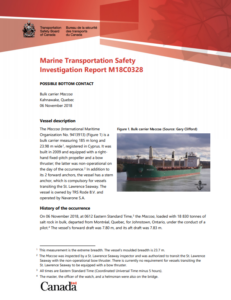Canada’s Transportation Safety Board (TSB) issued an investigation report on a possible bottom contact involving the bulk carrier ‘Maccoa’ in Kahnawake, Quebec, in November 2018. TSB noted that when a vessel approaches a Seaway lift bridge and the bridge cannot be raised to allow the vessel to pass, the vessel’s master or pilot must take appropriate action to avoid passing the limit of approach sign.
The incident
On 6 November 2018, at 0935, the Maccoa left the Saint-Lambert Lock, making speed of about 6 knots as required by St. Lawrence Seaway regulations for vessels navigating along the South Shore Canal.
The Maccoa reached the Côte Sainte-Catherine Lock at 1054 and left the lock at 1120. The pilot and a Seaway traffic controller planned for the vessel to pass Seaway bridges 7A and 7B, which are equipped with lift spans,before 1240, when the next passenger train was scheduled to cross.
At 1144, in anticipation of the Maccoa’s arrival at bridges 7A and 7B, a Seaway bridge operator asked a Canadian Pacific Railway (CP) rail traffic controller in Calgary, Alberta, for control of the bridges via their automated control system.
Moments later, the Seaway bridge operator realized that bridge control had not been transferred and that the bridge spans were not lifting for the Maccoa. He informed the Seaway traffic controller of the situation.
As required by procedure, the Seaway bridge operator then contacted the rail traffic controller via telephone to clarify the situation and determine why control had not been transferred.
The rail traffic controller put the Seaway bridge operator on hold as he attempted to contact the CP contractor performing scheduled rail maintenance on one of the bridge spans that day. The contractor did not immediately respond to the rail traffic controller.
At 1145, the Seaway traffic controller used the VHF radiotelephone to inform the Maccoa’s pilot of the situation. At that time, the Maccoa was 2.06 nm from the limit of approach sign, indicated on the nautical chart by a diamond labelled with “L A”, and 2.09 nm from the bridges.
Immediately after the VHF call, the pilot ordered the main engine to slow ahead, quickly followed by dead slow ahead. At about 1146, the pilot gave an order to stop the engine.
With the rudder in amidships position, the vessel moved toward the left side of the canal. To compensate for the movement, the pilot ordered hard to starboard. The ship’s bow quickly moved towards the canal’s right side. To compensate for that movement and regain control of the vessel, the pilot ordered various emergency manoeuvres using both the rudder and the engine.
Despite these manoeuvres, the vessel continued toward the right side of the canal. At approximately 1150, the pilot ordered full speed astern to avoid running aground.
At 1154, the vessel came close to the navigable limit on the canal’s right side. The pilot informed the Seaway traffic controller of the incident, and the crew recorded possible bottom contact in the Maccoa’s log book. The crew also verified that there was no water ingress or damage to the vessel.
At approximately 1215, the Maccoa passed under Seaway bridges 7A and 7B and continued its voyage to Johnstown.
Lessons learned
Vessels approaching Seaway lift bridges
When a vessel approaches a Seaway lift bridge and the bridge cannot be raised to allow the vessel to pass, the vessel’s master or pilot must take appropriate action to avoid passing the limit of approach sign,
…the report reads.
Typically, the master or pilot will reduce vessel’s speed as much as possible while preserving steering capability.
In an emergency situation, the master or pilot can drop an anchor. If the vessel is downbound and approaching bridges 7A and 7B, it can stop at the emergency floating dock located 0.25 nm upstream from the bridges.
Factors such as vessel size, momentum, current, the width and depth of the canal, and adverse weather conditions may make it difficult to perform these emergency manoeuvres within the canal.
Explore more herebelow:
See also:































































